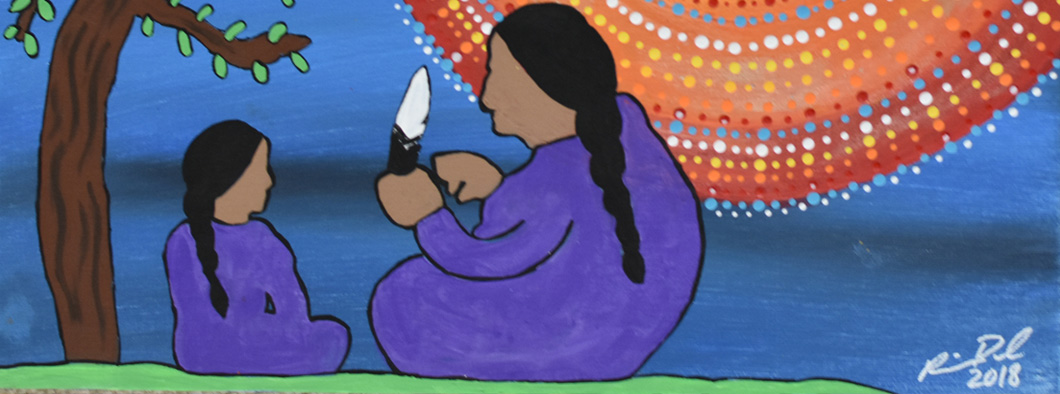Il-mimajua’tmk Tan’n Teli-L’nuimk
Renewing Our Culture: Transmitting Our Languages and Songs
Minuwi Kcitomitahatomonen Skicinuwawsuwakonon: Namkomihptasuwol Latuwewakonol naka Skicinuwintuwakonol
Theme:
Ta’n Wenin
Identity
Tan Wen Wetapeksit
Global Competencies
Critical Thinking and Problem Solving
- Learners engage in an inquiry process to solve problems, as well as acquire, process, interpret, synthesize, and critically analyze information to make informed decisions. (Activity 3)
- Learners select strategies, resources, and tools to support their learning, thinking, and problem-solving and evaluate the effectiveness of their choices. (Activity 2)
- Learners see patterns, make connections, and transfer their learning from one situation to another, including real-world applications. (Activity 2 and 3)
- Learners construct, relate and apply knowledge to all domains of life, such as school, home, work, friends, and community. (Activity 2)
- Learners formulate and express questions to further their understanding, thinking, and problem-solving. (Activity 2)
Innovation, Creativity, and Entrepreneurship
- Learners formulate and express insightful questions and opinions to generate novel ideas. (Activity 1)
- Learners turn ideas into value for others by enhancing ideas or products to provide new-to-the-world or improved solutions to complex social, ecological, and economic problems or to meet a need in a community. (Activity 1)
- Learners take risks in their thinking and creating; they discover through inquiry research, hypothesizing, and experimenting with new strategies or techniques. (Activity 1)
- Learners enhance concepts, ideas, or products through a creative process. (Activity 1)
Self-Awareness and Self-Management
- Learners develop a positive identity, sense of self, and purpose from their personal and cultural qualities. (Activity 2)
- Learners are aware of, manage, and express their emotions, thoughts, and actions in order to understand themselves and others. (Activity 1 and 2)
Collaboration
- Learners participate in teams by establishing positive and respectful relationships, developing trust, and acting interdependently and with integrity. (Activity 3)
- Learners learn from and contribute to the learning of others by co-constructing knowledge, meaning, and content. (Activity 3)
- Learners demonstrate empathy for others in a variety of contexts. (Activity 3)
Communication
- Learners communicate effectively in French and/or English and/or Mi’kmaw or Wolastoqey Latuwewakon through a variety of media and in a variety of contexts. (Activity 2)
- Learners gain knowledge about a variety of languages beyond their first and additional languages; they recognize the strong connection between language and ways of knowing the world. (Activity 2)
- Learners ask effective questions to create a shared communication culture, to understand all points of view, express their own opinions, and advocate for ideas. (Activity 3)
Global Citizenship and Sustainability
- Learners understand the interconnectedness of social, ecological, and economic forces, and how they affect individuals, societies, and countries. (Activity 3)
- Learners recognize discrimination and promote principles of equity, human rights, and democratic participation. (Activity 2 and 3)
- Learners understand Indigenous worldviews, traditions, values, customs, and knowledge. (Activity 1, 2 and 3)
- Learners take actions and make responsible decisions that support social settings, natural environments, and quality of life for all, now and in the future. (Activity 3)
- Learners contribute to society and to the culture of local, national, global, and virtual communities in a responsible, inclusive, accountable, sustainable, and ethical manner. (Activity 3)
Curriculum Outcomes
English Language Arts
Specific Curriculum Outcomes
- 1. Listen critically to others’ opinions and points of view (Activity 3)
- 2. Contribute to and respond constructively in conversation, small-group and whole group discussion, recognizing their roles and responsibilities as speakers and listeners (Activity 3)
- 2. Engage in, respond to, and evaluate oral presentations (Activity 2)
Health
Specific Curriculum Outcomes
- 2.1 Identify sources and signs of stress as well as ways to manage it (Activity 2)
Mathematics
- 2.1 Patterns and Relations – Determine the pattern rule to make predictions about subsequent terms (Activity 1)
Social Studies
Specific Curriculum Outcomes
- 5.1.1 Develop an understanding of how we learn about the past (Activity 1, 2 and 3)
- 5.4.2 Examine decision-making practices in First Nations societies in what later became Atlantic Canada (Activity 3)
Visual Arts
- Principles of Design – Discuss simple compositional elements in their artwork and the artwork of others, e.g., horizontal line, area of emphasis, symmetrical balance, repeating shapes (Activity 1)
- Apply different kinds of line in their own artwork and identify line in the work of artists and in nature (Activity 1)
Associated Text Materials
Grade 5 – Investigating Past Societies*
- p. 85 Mi’kmaw Clothing
- p. 88 Wolastoqewiyik Clothing
- p. 96 Make Decisions by Consensus
* Although the textbook is titled “Investigating Past Societies”, it should be noted that it also deals with societies that exist now.





